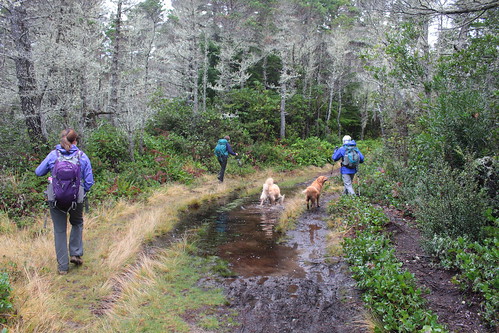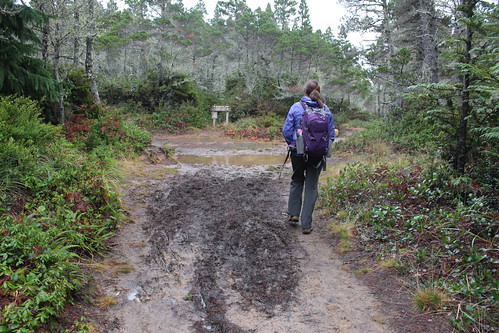Rosie, in her element
















The first comprehensive look at Oregon’s wine industry in four years estimates it has grown to have an economic impact of $3.35 billion, counting direct and related sales, jobs, services and products.
The report by Full Glass Research describes an industry on a post-recession roll, with planted acres increasing by 18 percent since 2011, the number of wineries up 45 percent and a 39 percent increase in sales.
Oregon grape growers and wine makers have successfully focused on making higher-priced, higher-quality wine, especially the signature Pinot noir, “turning the state’s low yields and tricky climate into an asset,” according to the report.
“Oregon growers continue to achieve the highest average price per ton while Oregon wineries realize the highest average revenues per case,” according to the report.
Wine grapes aren’t even in Oregon’s top 10 most valuable crops. The National Agricultural Statistics Service list grapes 11th in 2013 at $107 million; Full Glass Research lists the crop value at $128 million. But the report details an industry that “punches above its weight,” as a publicist put it, and has economic ripples ranging from the production of oak barrels and steel tanks to money spent by tourists in tasting rooms.
Among the points of interest in the report:
• There are 17,000 “wine-related” jobs in Oregon and the industry produced 2.7 million nine-liter cases in 2013.
• Despite dramatic growth, small to medium size producers prevail in Oregon. The state’s three largest producers would rank 52nd, 53rd and 76th in California.
• Oregon consumes 36 percent of its own wine production and exports the rest. Among international export markets, Canada takes more than one-third. Japan is second, with Mexico, Hong Kong and Scandinavian countries emerging as the fastest growing markets.
• A Wine Opinions national consumer panel showed regular purchasing of Oregon wines among high end consumers increased from 22 percent in 2008 to 41 percent in 2013. The “romance and appeal” of wineries and “upscale demographics” of wine consumption assures that wine tourists spend more than other visitors.
• In 2013, Oregon wineries spent $11.5 million on corks and other bottle closures, $21.9 million on glass, at least $8.4 million on steel tanks and $5 million to $7 million on barrels. They also spent about $10.4 million for 37 million labels.
• Annual vineyard costs for cultivation, pruning, weed control and trellising range from $3,500 to $8,000 per acre.
• The average per acre cost of developing a vineyard is $20,625. That includes soil prep, layout, planting, trellising, vines, rootstock, irrigation and other costs, but not the purchase price.
• Change may be coming. From 2012-14, four of the top 20 largest wine companies in the U.S., including Kendall Jackson, and three companies from the famous Burgundy region of France, purchased or expanding holdings in Oregon.
Farmed Smart certification offers regulatory ‘safe harbor,’ leader says
By Matthew Weaver
Capital Press
KENNEWICK, Wash. — The Pacific Northwest Direct Seed Association is looking for farmers to sign up for a new certification program that will provide farmers a “safe harbor” from some regulatory agencies.
Association executive director Kay Meyer described the program, called Farmed Smart, during the Pacific Northwest Oilseed and Direct Seed Conference in Kennewick, Wash.
Third-party auditors would certify farms that employ conservation practices and transition to direct seeding, Meyer said.
“We’ve got our regulatory agencies on board, saying if farmers are getting certified, they are achieving water quality standards because of these practices that they are implementing,” Meyer said.
The association is creating a memorandum of understanding with the Washington Department of Ecology defining management practices.
The program has credibility, said Chad Atkins, water quality specialist for the department in Eastern Washington.
“We’re used to looking for problems and then holding the hammer over people in order to get those fixed,” Atkins said. “This provides an opportunity to come at it from a different direction — rewarding producers for environmental protection.”
Campbell’s, Wal-Mart and Pepperidge Farms already see the program as a way to meet their sustainability initiatives, Meyer said.
The association hopes to certify 200 farms, or roughly 400,000 acres, in the Pacific Northwest. The first 10 farmers would pay no certification fee, and the next 30 would pay a reduced fee.
Genesee, Idaho, farmer Russ Zenner said he already has Food Alliance certification as a producer for Shepherd’s Grain, and said Farmed Smart is similar. Food Alliance certification concentrates on sustainable farming practices.
Mark Sheffels, a Wilbur, Wash., farmer, said some aspects of the program, such as buffers along streams, potentially represent a significant economic sacrifice for farmers because of maintenance costs and weed problems.
“Our part of the world is typically the most productive dirt (anywhere),” Zenner agreed. “There’s going to have to be significant incentive to take that out of production.”
Sheffels said the criteria is tough, but doable. It’s also timely, as farmers realize there will be greater expectations for agriculture in the future, he said.
“Everybody expects more regulatory scrutiny in the future and being part of this program says you recognize that and you’ve already addressed it,” he said.
POCATELLO, Idaho — Researchers say the number of potato psyllids found harboring the Liberibacter bacteria that causes the crop disease zebra chip dropped significantly in the Pacific Northwest during 2014.
A new study out of Washington, however, has heightened concerns about resident psyllid populations overwintering in the Pacific Northwest.
Zebra chip, which causes bands in potato flesh that darken when fried, first arrived in the Pacific Northwest in 2011. By 2012, infections remained minimal as a percentage of the overall Idaho crop but ran as high as 15 percent in certain spud fields, said University of Idaho Extension entomologist Erik Wenninger.
In 2013, 33 of 1,093 psyllids captured through a UI monitoring program tested positive for Liberibacter.
Just 170 psyllids were captured in 2014, with four testing positive for Liberibacter. No infected spud plants were found.
Almost all of Idaho’s 2014 psyllids were of the Northwest haplotype, compared with 2013 when many Western psyllids were also found, suggesting to Wenninger that there may have been more “homegrown” psyllids this year, rather than insects blowing in from other regions.
Oregon State University tested 15,000 psyllids in 2014 — half of the 2013 total — finding 0.5 percent were positive for Liberibacter and “few plants in the field were symptomatic.”
Washington’s monitoring program confirmed only two Liberibacter-positive psyllids of 1,000 tested, said Joe Munyaneza, a research entomologist with USDA’s Agricultural Research Service in Yakima, Wash. Munyaneza led an experiment showing psyllids that feed on bittersweet nightshade — a common plant in the Northwest known to support the bugs between potato crops — seem to have greater cold hardiness than insects that feed on potatoes alone.
“We believe the bittersweet nightshade is conferring some cold-hardy property to the psyllids,” Munyaneza said.
Munyaneza’s team has also found a second psyllid host plant, called goji berry, or Lycium. His team continues to find psyllids surviving at five Washington goji berry sites.
Wenninger said Idaho’s monitoring program thus far shows psyllids arrive in Idaho during the second week of June, with numbers gradually increasing as the season progresses and higher populations found further west in the state, where temperatures are higher.
During the past two seasons, the network has included intensive weekly monitoring of 13 fields with vacuum samples and 10 sticky traps, plus light weekly monitoring of 75-94 fields using four sticky traps. UI has base funding through a federal grant to continue some level of monitoring, but has applied again for an Idaho Potato Commission grant to continue the exhaustive network.
“We’ve asked at several stakeholder meetings if people want us to keep sampling, and we’ve found pretty overwhelming support for it,” Wenninger said.
Other new psyllid research by Wenninger shows more than 90 percent infection in plants exposed to high densities of Liberibacter-positive psyllids at least seven weeks before harvest, compared with minimal infection by plants exposed closer to harvest. The study suggests to Wenninger growers may not be at especially high risk when psyllid numbers spike late in the season.
Other new research shows zebra chip infection increases in storage, but cooler temperatures can curb the rate of increase.
The Hazelnut Growers of Oregon cooperative is hoping to provide its farmers with a new benefit: peace of mind.
Pasteurization equipment recently installed at its processing facility in Cornelius, Ore., will provide a “kill step” for diseases like salmonella and E. coli, which have prompted hazelnut recalls and attracted scrutiny from the U.S. Food and Drug Administration.
“It’s somewhat of a firewall between them and the FDA,” said Jeff Fox, CEO of the cooperative.
By heating nuts to nearly 200 degrees Fahrenheit and treating them with pressurized steam, the pasteurization equipment results in a 100,000-fold reduction in pathogenic microbes.
The process is expected to shield hazelnut farmers from the FDA’s regulatory muscle, thereby growing the cooperative’s community of suppliers.
The FDA will require processors to identify disease risks and tailor specific remedies under proposed food safety rules that will be finalized this year, said Charles Breen, a food industry consultant and former agency official.
Growers who produce crops meant for raw consumption will also be subject to a “produce safety” rule that governs on-farm practices.
It’s likely that hazelnut growers who document their crops are treated with this “kill step” will not fall under the FDA’s on-farm purview, Breen said.
“The agency will probably accept it as an appropriate measure to control a hazard,” he said. “I think this approach is one that will reduce FDA’s interest in farms that are growing nuts subject to this process.”
On-farm measures to prevent microbes are difficult for hazelnuts, which are harvested from the ground in orchards that are tough to protect from animal incursions.
Some bacteria can persist in the soil for years and live independently from animal digestive tracts, said Philippe Cornet, food safety and quality supervisor for HGO.
Even expensive fencing would not ensure the exclusion of pathogens, since birds fly over orchards, he said. “You would have to put it in a bubble and sterilize the soil.”
The cooperative expects to reap other rewards from the new pasteurization line — improved food safety is expected to win new customers and reduce costs over time, said Fox.
The cooperative has spent approximately $3 million on the pasteurization project and expects a payback time of about five years on the investment, he said.
Reduced transportation will provide measurable savings, as HGO will no longer have to ship hazelnuts to California for treatment with propylene oxide, a chemical used for sterilization.
“Freight costs are rather expensive and the treatment itself was rather expensive,” Fox said.
Apart from direct costs, the propylene oxide treatment slowed hazelnut deliveries to HGO’s customers. With on-site pasteurization, the turnaround for clients will be much faster, he said.
The cooperative’s insurance premiums are expected to fall due to the pasteurization line and it will be able to reduce sampling and testing costs.
Avoiding a potential disease outbreak offers another major advantage, Fox said. “Recalls are very expensive.”
Before installing the pasteurization machinery, HGO had to resolve some serious questions about the technology.
The main concern was the potential impact to sensory qualities, Fox said. “That was probably one of the biggest things.”
If pasteurization dried the crop excessively, the nuts would taste different and their weight would be reduced, denting revenues for the cooperative. Altered color was another worry.
After treating hazelnuts at a pilot plant of the equipment’s manufacturer, Napasol, HGO found that any changes were negligible and decided to move forward with the project, Fox said.
While pasteurization is new to the hazelnut industry — which is centered in the Northwest — other tree nut growers in California have successfully adopted the technology, said Cameon Ivarsson, scientific director for Napasol.
“Everybody is going in that direction in the U.S.,” she said.
The move to pasteurization was initiated by the almond industry, which mandated the process under a federal marketing board order in 2007, Ivarsson said.
Since then, walnut, macadamia and pistachio processors in the state have begun treating their crops voluntarily, she said.
Pasteurization with heat and pressurized steam is growing in popularity because the European Union prohibits propylene oxide treatments due to fears of carcinogenic byproducts, Ivarsson said.
Processors who sell in the U.S. market are taking notice, since some domestic consumers have also raised concerns about the chemical, she said. “There’s a potential for backlash.”
Oregon’s farm industry will be more vulnerable to “bad bills” this year due to larger Democratic majorities in the state legislature, said Sen. Betsy Johnson, D-Scappoose.
Proposals that harm agriculture — such as legislation that would raise fuel prices — will be hard to block now that Democrats have gained two seats in the Oregon Senate for an 18-12 majority and one more in the House for a 35-25 majority, she said.
“This is not a session to be passive. Ag and natural resources are under assault,” Johnson said at the Dunn Carney law firm’s Ag Summit in Wilsonville on Jan. 21.
However, lawmakers may be nervous about approving bills that cause “pain at the pump” for voters and are willing to listen to constituents more than lobbyists, she said.
Growers should pay close attention to proposed bills and inform their local lawmakers on how they affect agriculture, Johnson said. “Be a resource for your legislators.”
Gov. John Kitzhaber will probably push aggressively for energy and environmental legislation, such as extending the state’s low carbon fuel standard, which is expected to substantially increase prices, she said.
Attempts to impose new taxes or raise existing ones are also likely, as are proposals for a major hike in the minimum wage, Johnson said.
“I hope we’re not rushing iconic bills though without understanding unintended consequences,” she said.
Proposals to raise the hourly minimum wage from $9.25 to $12 or even $15 are expected to gain traction, which will probably prompt some businesses to mechanize and cut jobs, said Katie Fast, vice president of public policy for the Oregon Farm Bureau.
A bill to impose mandatory paid sick leave for employees “definitely has legs this session,” while other legislation would remove a state pre-emption statute that blocks local governments from setting their own minimum wages, Fast said.
Lawmakers are also expected to propose new regulations for pesticides — particularly aerial spraying — as well as genetically modified crops, said Katy Coba, director of the Oregon Department of Agriculture.
Coexistence among different types of agriculture is gaining more attention among legislators, she said. “We’re seeing more and more challenges in this area.”
Select the newsletter(s) to which you want to subscribe or unsubscribe.